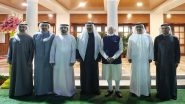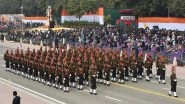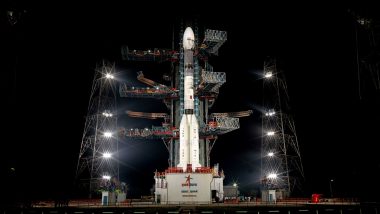Sriharikota (Andhra Pradesh), May 29 : Indian rocket Geosynchronous Satellite Launch Vehicle (GSLV) on Monday morning blasted off successfully with the first of the second generation navigation satellite code named NVS-01 from the rocket port here. The three staged GSLV rocket standing 51.7 metre tall and weighing 420 ton rose up into the skies at 10.42 a.m. breaking free of the earth's gravitational pull. The rocket carried India's first of India's second generation navigation satellites NVS-01 weighing 2,232kg.
Interestingly, for the first time, an indigenous rubidium atomic clock developed by Indian Space Research Organisation's (ISRO) Space Applications Centre (SAC), Ahmedabad is being flown in NVS-01. As the GSLV rocket ascended, its engine roar reverberated over the rocket port like a rolling thunder much to the thrill of the people there. ISRO Conducts First Test of Its Semicryogenic Engine at New Test Facility.
ISRO Successfully Launches NVS-01 Satellite:
#WATCH | Indian Space Research Organisation (ISRO), launches its advanced navigation satellite GSLV-F12 and NVS-01 from Sriharikota.
(Video: ISRO) pic.twitter.com/2ylZ8giW8U
— ANI (@ANI) May 29, 2023
Simply put, the NavIC an acronym for Navigation with Indian Constellation (formerly with a long winding name Indian Regional Navigation Satellite System (IRNSS) is similar to the GPS (Global Positioning System) of the US, Glonass of Russia and Galileo of Europe as well as China's Beidou. India From Space Photos: ISRO Shares First Images of Earth Taken by OceanSat-3 and Here's How India Looks.
A fully developed NavIC system consists of seven satellites in Geosynchronous/Inclined Geosynchronous orbits. It will provide real time positioning and timing services over India and a region extending approximately 1,500km around the Indian mainland. About 19 minutes into the flight, the GSLV rocket will deliver the satellite into a Geosynchronous Transfer Orbit (GTO) from where it will be further taken up by firing the onboard motors.
The satellite with a mission life of 12 years is powered by two solar arrays capable of generating power upto 2.4kW and a lithium-ion battery during the eclipse. NVS series of satellites will sustain and augment the NavIC with enhanced features. This series has payloads that operate on L1, L5 and S bands thereby widening its services.
The L1 navigation band is popular for providing Position, Navigation and Timing (PNT) services for civilian users and for interoperability with other Global Navigation Satellite System (GNSS) signals, ISRO said. "In addition to L1 band, we have a highly secured code for strategic signals in L5 and S bands," a senior ISRO official told IANS.
Currently there are eight first generation NavIC satellites in orbit. India had already launched nine first generation NavIC satellites including the two standby satellites.
The first standby satellite was lost in the sky as the heatshield of the Polar Satellite Launch Vehicle (PSLV) did not open which necessitated the orbiting of the second standby.
The standby satellites were used as the country's first navigation satellite IRNSS-1A was not performing to the mark owing to the failure of its imported rubidium atomic clocks. The atomic clocks are important to give accurate positional data.
According to the ISRO official, out of the eight NavIC satellites in orbit four are functional for navigation services and four others are messaging services. Be that as it may, ISRO had used imported atomic clocks on all the nine navigation satellites it had launched earlier.
It was said the NavIC satellites were performing well till the atomic clocks in IRNSS-1A failed. Sources in ISRO had earlier told IANS some of the atomic clocks in a couple of other satellites too were not functioning properly. The clocks are used for precise time and location.
Each NavIC satellite had three atomic clocks. The outlay for the IRNSS/first generation NavIC systems was said to be about Rs 1,420 crore. The eight NavIC satellites that are in orbit now are: -IRNSS-1A, IRNSS-1B, IRNSS-1C, IRNSS-1D, IRNSS-1E, IRNSS-1F, IRNSS-1G and IRNSS-1I. The NVS-01 will become the ninth one if the mission is successful.
(The above story first appeared on LatestLY on May 29, 2023 11:21 AM IST. For more news and updates on politics, world, sports, entertainment and lifestyle, log on to our website latestly.com).













 Quickly
Quickly


